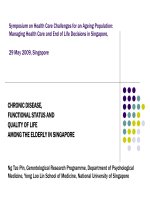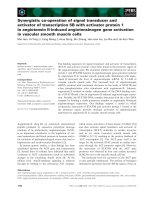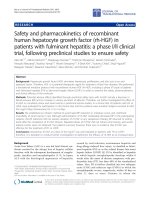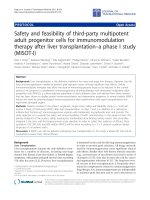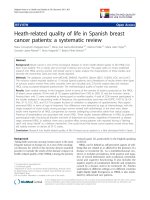Safety and feasibility of adjuvant chemotherapy with S-1 in Japanese breast cancer patients after primary systemic chemotherapy: A feasibility study
Bạn đang xem bản rút gọn của tài liệu. Xem và tải ngay bản đầy đủ của tài liệu tại đây (395.17 KB, 7 trang )
Shigekawa et al. BMC Cancer (2015) 15:253
DOI 10.1186/s12885-015-1289-7
RESEARCH ARTICLE
Open Access
Safety and feasibility of adjuvant chemotherapy
with S-1 in Japanese breast cancer patients after
primary systemic chemotherapy: a feasibility
study
Takashi Shigekawa1, Akihiko Osaki1, Hiroshi Sekine2, Nobuaki Sato3, Chizuko Kanbayashi3, Hiroshi Sano1,4,
Hideki Takeuchi1, Shigeto Ueda1, Noriko Nakamiya1, Ikuko Sugitani1, Michiko Sugiyama1, Hiroko Shimada1,
Eiko Hirokawa1, Takao Takahashi1 and Toshiaki Saeki1*
Abstract
Background: Advanced breast cancer patients have a higher risk of postoperative recurrence than early-stage breast
cancer patients. Recurrence is believed to be caused by the increase in micrometases, which were not eradicated by
preoperative or postoperative chemotherapy. Therefore, a new therapeutic strategy that can improve treatment
efficacy is mandatory for advanced breast cancer. S-1 was shown to be effective and safe in Japanese metastatic breast
cancer patients treated with previous chemotherapy, including anthracyclines. Thus, in this study, we evaluated S-1 as
adjuvant chemotherapy in breast cancer patients after standard primary systemic chemotherapy.
Methods: The treatment consisted of 18 courses (a 2-week administration and a 1-week withdrawal; one year)
administered at 80–120 mg/body/day. In cases judged to require postoperative radiotherapy, it was concurrently
initiated on Day 1 of the study. If the estrogen receptor and/or human epidermal growth factor receptor 2 were
positive, endocrine therapy and/or trastuzumab were permitted, concurrently.
Results: Of the 45 patients enrolled between September 2007 and September 2009 from 3 institutions, 43 patients
were eligible. Thirty-two of the 43 (74.4%) patients received concurrent radiotherapy. Twenty-two of the 43 (51.2%)
patients completed the scheduled courses of chemotherapy. The most common reasons for withdrawal of treatment
were subjective symptoms, such as nausea, anorexia, or general fatigue during the first 9 courses of treatment
in 9/43 (20.9%) patients, recurrence in 7/43 (16.3%) patients, and adverse events in 5/43 (11.6%) patients. The
cumulative percentage of administration for 365 days was 66.4% (95% confidence interval: 50.8–79.1%).
Although grade 3 neutropenia (9.3%), leukopenia (4.7%), and diarrhea (4.7%) were observed, they were
manageable. No grade 4 adverse effects were observed.
Conclusions: The percentage of Japanese breast cancer patients completing the 18-course treatment and the
cumulative percentage of administration for 365 days using S-1 after standard primary systemic chemotherapy
were similar with the results of another study of adjuvant chemotherapy for the Japanese gastric cancer
patients with no severe adverse effects. A phase III trial investigating the usefulness of adjuvant S-1 is now
ongoing in Japan, and it is expected that S-1 will have a significant survival benefit in breast cancer patients.
UMIN000013469.
Keywords: Advanced breast cancer, S-1, Adjuvant chemotherapy, Primary systemic chemotherapy
* Correspondence:
1
Department of Breast Oncology, Saitama Medical University International
Medical Center, 1397-1 Yamane, Hidaka-shi, Saitama 350-1298, Japan
Full list of author information is available at the end of the article
© 2015 Shigekawa et al.; licensee BioMed Central. This is an Open Access article distributed under the terms of the Creative
Commons Attribution License ( which permits unrestricted use, distribution, and
reproduction in any medium, provided the original work is properly credited. The Creative Commons Public Domain
Dedication waiver ( applies to the data made available in this article,
unless otherwise stated.
Shigekawa et al. BMC Cancer (2015) 15:253
Background
Primary systemic chemotherapy (PSC) is recommended as
a standard therapy in locally advanced breast cancer and,
at present, it is the standard of care for early-stage breast
cancer [1]. Advanced breast cancer patients have a higher
risk of postoperative recurrence than early-stage breast
cancer patients. The recurrence is believed to be caused
by the growth of micrometases, which could not be controlled by standard treatment. Therefore, a new therapeutic strategy that can improve the treatment effect is
mandatory for advanced breast cancer. S-1 is a dihydropyrimidine dehydrogenase (DPD)-inhibitory fluoropyrimidine (DIF), and it is combined with gimeracil, oteracil, and
tegafur in a molar ratio of 1:0.4:1. S-1 was shown to be effective and safe in Japanese metastatic breast cancer patients treated with previous chemotherapy, including
anthracyclines [2]. Another oral fluoropyrimidine-based
regimen, tegafur/uracil (UFT), was proven to be effective
as adjuvant chemotherapy in Japanese breast cancer
patients [3]. In addition, adjuvant chemotherapy with S-1
was useful in gastric cancer patients [4]. Thus, S-1 is expected to be a promising drug that may have a survival
benefit in the adjuvant setting. We evaluated the safety
and feasibility of adjuvant chemotherapy with S-1 for curatively resected advanced breast cancer patients after
standard PSC. There have been reports of S-1 with concurrent radiotherapy in several types of cancer patients
[5,6]; therefore, concurrent administration was planned
and performed in patients judged to require postoperative
radiotherapy.
Methods
Design of the study
This was a multicenter, non-blinded, open-label, feasibility study. The primary endpoints of this study were the
percentage of the eligible patients completing the 18course treatment and the cumulative percentage of
administration for 365 days using S-1. The secondary
endpoint was safety. In PSC, the clinical response was
evaluated by ultrasonography according to the Response
Evaluation Criteria In Solid Tumors (RECIST) version
1.1., and the pathological response was assessed according to the criteria established by the Japanese Breast
Cancer Society. In the criteria, pathological complete response (pCR) was defined as necrosis and/or disappearance of all tumor cells, and/or the replacement of cancer
cells by granulation and/or fibrosis. If only ductal components remained, the pathological response was described as a pCR. The adverse events were evaluated
with Common Terminology Criteria for Adverse Events
v3.0 (CTCAE v3.0) and the frequency of the worst grade
was reported. In this trial, on the basis of the annual
number of patients receiving PSC followed by surgery,
we determined feasibility. The sample size was estimated
Page 2 of 7
to be approximately 40 patients, without any calculations based on statistical assumptions.
Patient eligibility criteria
Patient eligibility criteria for this study were as follows: (1)
breast cancer with histological confirmation; (2) Stage II or
III breast cancer (AJCC Cancer Staging Manual. 7th
edition) and previous standard anthracycline and
taxane-based PSC, followed by curative surgery; (3) age
20–75 years; (4) Eastern Cooperative Oncology Group
performance status 0–1; (5) adequate gastrointestinal
function; (6) adequate organ function [leukocytes ≥4000/
mm3; neutrocytes ≥2,000/mm3; platelets ≥100,000/mm3;
hemoglobin ≥9.0 g/dl; serum total bilirubin ≤1.5 mg/dl;
aspartate aminotransferase (AST) and alanine aminotransferase (ALT) <2.5 times the normal limits at each institution; and serum creatinine, ≤1.5 mg/dl].
Patients with serious complications, a history of drug
hypersensitivity, brain metastases with any symptoms,
active secondary cancer, or pregnant women were excluded. This study was performed in accordance with
the ethical principles of the Declaration of Helsinki and
was approved by the institutional review board of all
participating hospitals (Saitama Medical University
International Medical Center, Niigata Cancer Center
Hospital, and Sasaki Memorial Hospital). Informed consent was obtained from all patients prior to enrollment
in this study by written.
Treatment schedule
36 patients (83.7%) received PSC with epirubicin 90 mg/
m2 and cyclophosphamide 600 mg/m2 q3w followed by
docetaxel 75 mg/m2 q3w. 3 patients (7.0%) received PSC
with docetaxel 75 mg/m2 q3w followed by epirubicin
90 mg/m2 and cyclophosphamide 600 mg/m2 q3w. In 4
patients (9.3%), PSC with epirubicin 90 mg/m2 and
cyclophosphamide 600 mg/m2 q3w was administered,
and because of the toxicity of anthracycline, it was impossible to continue docetaxel for them. Adjuvant
chemotherapy consisted of 18 courses (a 2-week administration and a 1-week withdrawal; one year) of S-1
(tegafur, gimeracil, and oteracil potassium; Taiho
Pharmaceutical, Tokyo, Japan) administered orally at
80–120 mg/body/day, twice daily after breakfast and
dinner, according to the body surface area (BSA).
Patients with BSA <1.25 m2 received 80 mg/day. Patients
with BSA ≥1.25 and <1.5 m2 received 100 mg/day.
Patients with BSA ≥1.5 m2 received 120 mg/day. The
treatment was started within 28 days after curative surgery. In cases judged to require postoperative radiotherapy, concurrent administration was performed. Treatment
was initiated on Day 1 of the study. A fractional daily dose
of 2.0 Gy (5 days/week), up to a total dose of 50.0 Gy, was
prescribed, and boost radiation of 10.0 Gy/5 fr was
Shigekawa et al. BMC Cancer (2015) 15:253
permitted, if needed. In estrogen receptor and/or progesterone receptor (ER and/or PgR)-positive cases, endocrine
therapy (premenopausal, tamoxifen; postmenopausal,
letrozol) was permitted concurrently. In human epidermal
growth factor receptor 2 (HER2)-positive cases, trastuzumab was also permitted concurrently. Treatment was discontinued when the patient had recurrence of disease or
adverse reactions unable to be controlled by dose modification or temporary withdrawal of S-1. Treatment was
also discontinued at patient request. Adverse events were
assessed using the National Cancer Institute Common
Toxicity Criteria (version 3.0).
Page 3 of 7
patient underwent a non-curative operation. The demographic and clinical characteristics of the 43 eligible patients are summarized in Table 1. Thirty-two of the 43
(74.4%) patients received concurrent radiotherapy.
Endocrine therapy was concurrently administered in 26
of the 43 (60.5%) patients with S-1. In 2008, after trastuzumab was available for use in an adjuvant setting by
a medical service under health insurance, trastuzumab
was concurrently administered with S-1 in 2 of the 43
(4.7%) patients.
Feasibility
The cumulative percentage of administration for
365 days using S-1 was evaluated using the Kaplan–
Meier method, and a 95% confidence interval (CI) was
calculated.
Compliance of S-1 for each course in the eligible patients
and in the patients without recurrence is shown in Table 2.
As shown in Table 2, 22 of the 43 (51.2%) eligible patients
completed the 18-course treatment. Reasons for discontinuing treatment were patient refusal (9 patients, 20.9%),
recurrence of disease (7 patients, 16.3%), and adverse reactions (5 patients, 11.6%). The cumulative percentage of administration for 365 days was 66.4% (95% CI: 50.8–79.1%)
(Figure 1). The compliance of the 18-course treatment was
2 of 5 (40%) patients in S-1 alone group, 4 of 12 (33%) patients in S-1 with radiation group, 5 of 6 (83%) patients in
S-1 with endocrine therapy group, and 11 of 20 (55%) patients in S-1 with radiation and endocrine therapy group.
As shown in Table 2, the 9 patients who refused to continue in the study did so during the first 9 courses. All 9 patients discontinued because of subjective symptoms, such
as nausea, anorexia, or general fatigue. Of those 9, 7
(77.8%) patients received concurrent radiotherapy between
the first 2 courses, 6 (66.7%) patients received concurrent
endocrine therapy, and 5 (55.6%) patients received both
concurrent radiotherapy and endocrine therapy. None of
the patients received trastuzumab concurrently. The other
reasons for discontinuation of treatment were the detection
of recurrence in 7 patients and the decision of the investigators to terminate treatment because of adverse events or
complications in 5 patients. Of the 5 patients who discontinued because of adverse events or complications, 2 (1 in
S-1 with radiation and endocrine therapy group and 1 in S1 with radiation group) had myelosuppression, 2 (1 in S-1
with radiation and endocrine therapy group and 1 in S-1
with radiation group)had elevated liver function, and 1 (in
S-1 with radiation and endocrine therapy group) had diarrhea. The dose of S-1 was decreased in 8 of the 43 (18.6%)
patients. Of the 22 patients who completed 18 courses of
chemotherapy, the dose was decreased in 6 patients.
Results
Toxicity
Patient characteristics
The adverse reactions experienced by the 43 patients
are listed in Table 3. Neutropenia, leukopenia, thrombocytopenia, anemia, elevated liver function, anorexia,
general fatigue, diarrhea, nausea, stomatitis, and pigmentation changes were comparatively frequent. Although
Dose modification
S-1 was temporally discontinued until recovery when
any of the following conditions were encountered: leukocytes, <2000/mm3; neutrocytes, <1000/mm3; platelets, <75,000/mm3; hemoglobin, <8.0 g/dl; serum total
bilirubin, ≥3.0 mg/dl; serum AST/ALT, >150 IU/L;
serum creatinine, >1.5 mg/dl, or when grade 2 or
higher non-hematological toxicity occurred. The permitted period of withdrawal because of adverse reactions was <14 days. If patients had hematological or
non-hematological toxicities of ≥ grade 3, their daily dose
was reduced from 120 to 100 mg, 100 to 80 mg, or 80 to
50 mg, and the dose reduction was permitted several
times until 50 mg before treatment interruption.
Follow-up
Patients underwent hematological tests and assessments of clinical symptoms at least once during each
course of chemotherapy. Recurrence was diagnosed on
the basis of imaging studies, mainly chest and abdominal computed tomography and bone scans, which
were performed at 6- and 12-month intervals, respectively, during the first 2 years after surgery. After that,
regular medical history reviews and physical examinations were performed every 6–12 months, and mammography was performed every 12 months according
to the American Society of Clinical Oncology clinical
practice guideline [7].
Statistical analysis
Among the 45 patients enrolled from 3 institutions between September 2007 and September 2009, 2 patients
were found to be ineligible after enrollment; 1 patient
withdrew consent to enter this trial, and the other
Shigekawa et al. BMC Cancer (2015) 15:253
Page 4 of 7
Table 1 Demographic and clinical characteristics of the
43 eligible patients
Table 1 Demographic and clinical characteristics of the
43 eligible patients (Continued)
Characteristics
No. of
patients
Tamoxifen + Trastuzumab
1(2.3%)
Eligible patients
43
No
15(34.9%)
PSC regimen
Gender
Female
43
Age (years)
Median
53
Range
32-71
Anthracycline-based regimen followed by taxane
regimen
36(83.7%)
Anthracycline-based regimen
4(9.3%)
Taxane regimen followed by anthracycline-based
regimen
3(7.0%)
Clinical response for RPC
ER status
Positive
28(65.1%)
CR
3(7.0%)
Negative
15(34.9%)
PR
26(60.4%)
SD
11(25.6%)
17(39.5%)
PD
3(7.0%)
26(60.5%)
Pathological response for RSC
PgR status
Positive
Negative
HER2 status
Non-p CR
38(88.4%)
Positive
5(11.6%)
p CR
5(11.6%)
Negative
38(88.4%)
BSA
<1.25 m2
0(0%)
1.25 m2 ≤ <1.50 m2
19(44.2%)
1.5 m2≤
24(55.8%)
Table 2 Compliance of S-1 for each course
Cycle
Completion rate in
number the eligible patients
Reasons for discontinuation of
treatment (The number of
patients)
Menopausal states
1
97.7%(42/43)
Adverse event(1)
Premenopausal
22(51.2%)
2
93.0%(40/43)
Patient refusal(2)
Postmenopausal
21(48.8)
3
90.7%(39/43)
Adverse event(1)
4
86.0%(37/43)
Patient refusal(2)
5
74.4%(32/43)
Patient refusal(3)
Histological classification
Invasive ductal carcinoma
41(95.4%)
Invasive lobular carcinoma
1(2.3%)
Apocrine carcinoma
1(2.3%)
Stage
IIA
Adverse event(1)
Recurrence(1)
6
69.8%(30/43)
69.8%(30/43)
Recurrence(1)
1(2.3%)
IIB
17(39.5%)
7
IIIA
4(9.3%)
8
69.8%(30/43)
IIIB
6(14.0%)
9
62.8%(27/43)
IIIC
15(34.9%)
10
32.8%(27/43)
24(55.8%)
11
60.5%(26/43)
19(44.2%)
12
60.5%(26/43)
13
55.8%(24/43)
Surgery
Mastectomy
Partial resection
Concurrent radiotherapy
Yes
32(74.4%)
No
11(25.6%)
Recurrence(1)
Adverse event(1)
Recurrence(1)
14
51.2%(22/43)
Adverse event(1)
Recurrence(1)
28(65.1%)
15
51.2%(22/43)
Tamoxifen
16(37.2%)
16
51.2%(22/43)
Letrozol
10(23.3%)
17
51.2%(22/43)
1(2.3%)
18
51.2%(22/43)
Trastuzumab
Patient refusal(1)
Recurrence(2)
Concurrent drug
Yes
Patient refusal(1)
Shigekawa et al. BMC Cancer (2015) 15:253
Page 5 of 7
Cumulative rate (%)
1.0
0.8
0.6
The cumulative rate of S-1 administration was 66.4%
(95%CI: 50.8–79.1%) for 365 days.
0.4
Number of patients at risk
0.2
33
29
24
0.0
0
100
200
300
Total duration of administration (days)
Figure 1 Cumulative percentage of S-1 administration for 365 days.
Censoring ticks show the patients who discontinued S-1 because of
adverse event, patient refusal, or recurrence.
grade 3 neutropenia (4 patients; 9.3%), leukopenia (2 patients; 4.7%), and diarrhea (2 patients; 4.7%) were observed, they were manageable. No grade 4 adverse events
were observed. There were no skin reactions of ≥ grade 3
in the surgical wound, although that was a concern in patients treated with concurrent radiotherapy.
Discussion
Meta-analyses have proven that the survival rates of preoperative and postoperative chemotherapy are equal. In
recent years, preoperative chemotherapy has become
Table 3 Adverse reactions (n = 43)
Grade
1
2
3
4
Total
n
n
n
n
n
(%)
Hematological toxicities
Neutropenia
7
8
1
0
19
(44.2%)
Leukopenia
5
21
2
0
28
(65.1%)
Thrombocytopenia
13
0
0
0
13
(30.2%)
Anemia (Hb)
11
3
0
0
14
(32.6%)
AST
12
0
0
0
12
(27.9%)
ALT
11
0
0
0
11
(25.6%)
Total bilirubin
7
1
0
0
8
(18.6%)
Creatinine
2
0
0
0
2
(4.6%)
24
4
0
0
28
(65.1%)
Non-hematological toxicities
Anorexia
General Fatigue
29
2
0
0
31
(72.1%)
Diarrhea
13
0
2
0
15
(34.9%)
Nausea
12
4
0
0
16
(37.2%)
Stomatitis
15
1
0
0
16
(37.2%)
Pigmentation changes
17
3
0
0
20
(46.5%)
3
1
0
0
4
(9.3%)
Rash
common for operable breast cancer patients [8,9]. In the
NSABP B-18, B-27, and Aberdeen trials, patients who
achieved a pathological complete response (pCR) had better
disease-free survival and overall survival than those who
did not [10,11]. In the NSABP B-27 trial, anthracyclinebased regimens followed by taxane regimens had higher
pCR rates than anthracycline-based regimens [12]. Thus, in
this study, we chose an anthracycline-based regimen
followed by a taxane regimen as the standard PSC. As a
new therapeutic strategy for advanced breast cancer that
can improve the treatment effect, we performed this first
pre-stage feasibility study of a randomized trial using S-1 in
an adjuvant setting.
S-1 is a DIF. Another DIF, UFT, was proven to be effective as adjuvant chemotherapy in Japanese breast cancer patients [3]. S-1 is the drug combined with
gimeracil, oteracil, and tegafur in a molar ratio of 1:0.4:1.
Tegafur was originally synthesized as a prodrug of 5fluorouracil (5-FU) and is converted to 5-FU in the liver
by cytochrome P450 2A6. 5-FU is promptly metabolized
by DPD in the liver; therefore, tegafur was combined
with uracil (UFT) or gimeracil (S-1) to inhibit DPD and
to increase the concentration of 5-FU. Gimeracil inhibits
approximately 200-fold DPD of uracil. Oteracil suppresses the activation of 5-FU, mainly in the gastrointestinal tract, and decreases gastrointestinal toxicity. Thus,
S-1 is considered to have high antitumor activity and
low gastrointestinal toxicity [13]. Advanced breast cancer can respond to S-1. In a phase II trial, S-1 showed a
high efficacy (an overall response rate of 41.7%) with low
toxicity [2]. S-1 is expected to be a promising drug,
which may have a survival benefit in the adjuvant setting. In Japanese gastric cancer patients, it was reported
that adjuvant chemotherapy with S-1 was useful [4].
Thus, it led to the idea of using S-1 as an adjuvant
chemotherapy for curatively resected advanced breast
cancer patients after standard primary systemic chemotherapy. It was reported that S-1 with concurrent radiotherapy has been used to treat several types of cancer
patients [5,6]; thus, concurrent administration was
planned and performed in patients judged to require
postoperative radiotherapy.
This is the first report examining adjuvant chemotherapy for breast cancer with S-1 after standard PSC. In this
study, we chose the schedule of a 2-week administration
and a 1-week withdrawal based on a report in pancreatic
cancer patients [5]. We felt that a 4-week continuous
medication schedule, without a rest, may be too toxic
for heavily pretreated breast cancer patients after standard PSC. In this feasibility study, there are the following
methodological limitations that because no statistical hypothesis was planned, this feasibility study was exploratory, generating and no demonstrating an hypothesis of
safety and feasibility of adjuvant chemotherapy with S-1,
Shigekawa et al. BMC Cancer (2015) 15:253
and that because of the small sample size and the wide
eligibility criteria it was impossible to identify patients at
particularly high/low risk of bad/good feasibility.
In our trial, the primary endpoints were the percentage
of the eligible patients completing the 18-course treatment and the cumulative percentage of administration
for 365 days using S-1, and they were 51.2% and 66.4%
(95% CI: 50.8–79.1%), respectively. Compared to the results of another study of adjuvant chemotherapy for the
Japanese gastric cancer patients [14], in which the
planned courses of S-1 (a 4-week administration and a
2-week withdrawal for 1 year) were administered in
60.7% of the patients, our result was acceptable. According to the results, no grade 4 adverse effects were observed. One drawback in this study was the high
incidence of patient refusal of the treatment during the
first 9 courses (the first half ) because of subjective symptoms, such as nausea, anorexia, or general fatigue. Those
symptoms were all grade 1 or grade 2. This problem (in
the first half ) may have been caused by the influence of
the adverse effects of PSC, surgery, and the concurrent
radiotherapy in the first 2 courses, or the concurrent
endocrine therapy. In this study, although treatment
with S-1 was started within 28 days after curative surgery, a delay in the start of drug administration may be
necessary to prevent this problem in the early courses.
The administration of radiotherapy and S-1 sequencially
instead of concurrently may yield a better result. Considering that the concurrent use of S-1 and endocrine therapy was feasible without any refusal and with a few
adverse event (only 2 cases) in the 9 cycles of the latter
half, the concurrent use of S-1 and endocrine therapy
may be acceptable. A randomized phase III trial comparing adjuvant S-1 plus standard hormonal therapy to
standard hormonal therapy alone in ER-positive and
HER2-negative primary breast cancer with intermediate
and/or high risk of recurrence is now ongoing in Japan
(POTENT: Postoperative Therapy with Endocrine and
TS-1, UMIN000003969). In this study, S-1 is administered using the same schedule as our study (a 2-week
administration and a 1-week withdrawal for 1 year) with
the concurrent endocrine therapy. It is expected that S-1
will have a significant survival benefit in breast cancer
patients.
Conclusions
In our study, the percentage of the eligible patients completing the 18-course treatment and the cumulative percentage of administration for 365 days using S-1 were
similar with the results of another study of adjuvant
chemotherapy for the Japanese gastric cancer patients,
and there were no severe adverse effects. A phase III
trial investigating the usefulness of concurrent S-1 and
endocrine therapy in the adjuvant setting is now ongoing
Page 6 of 7
in Japan. S-1 is expected to have a significant survival
benefit in breast cancer patients.
Abbreviations
PSC: Primary systemic chemotherapy; ER: Estrogen receptor alpha;
PgR: Progesterone receptor; BSA: Body surface area; HER2: Human epidermal
growth factor receptor 2; CI: Confidence interval; pCR: Pathological complete
response; DPD: Dihydropyrimidine dehydrogenase; DIF: DPD-inhibitory
fluoropyrimidine; UFT: Tegafur/uracil; 5-FU: 5-Fluorouracil.
Competing interests
The authors declare that they have no competing interests.
Authors’ contributions
TS1 and TS1* drafted the manuscript. TS1, AO, HS2, NS, and TS1* participated
in the design of the study and performed the statistical analysis. CK, HS1, 4,
HT, SU, IS, MS, HS1, EH, and TT conceived of the study, participated in its
design and coordination and helped in drafting the manuscript. All authors
read and approved the final manuscript.
Authors’ information
Takashi Shigekawa: A medical staff of the Department of Breast Oncology,
Saitama Medical University International Medical Center. A breast cancer
specialist certificated by the Japanese Breast Cancer Society.
Akihiko Osaki: A professor of the Department of Breast Oncology, Saitama
Medical University International Medical Center. A breast cancer specialist
certificated by the Japanese Breast Cancer Society.
Hiroshi Sekine: A previous associate professor of the Department of Breast
Oncology, Saitama Medical University International Medical Center. A present
professor of the Department of Radiology, Jikei University School of
Medicine. A breast cancer specialist certificated by the Japanese Breast
Cancer Society.
Nobuaki Sato: The assistant director of Niigata Cancer Center Hospital and a
director of the Department of Breast Oncology, Niigata Cancer Center
Hospital. A breast cancer specialist certificated by the Japanese Breast Cancer
Society.
Chizuko Kanbayashi: A medical staff of the Department of Breast Oncology,
Niigata Cancer Center Hospital. A breast cancer specialist certificated by the
Japanese Breast Cancer Society.
Hiroshi Sano: A previous medical staff of the Department of Surgery, Sasaki
Memorial Hospital. A present medical staff of the Department of Breast
Oncology, Saitama Medical University International Medical Center.
Hideki Takeuchi: A medical staff of the Department of Breast Oncology,
Saitama Medical University International Medical Center. A breast cancer
specialist certificated by the Japanese Breast Cancer Society.
Shigeto Ueda: A medical staff of the Department of Breast Oncology,
Saitama Medical University International Medical Center.
Ikuko Sugitani: A medical staff of the Department of Breast Oncology,
Saitama Medical University International Medical Center.
Michiko Sugiyama: A medical staff of the Department of Breast Oncology,
Saitama Medical University International Medical Center.
Hiroko Shimada: A medical staff of the Department of Breast Oncology,
Saitama Medical University International Medical Center.
Eiko Hirokawa: A medical staff of the Department of Breast Oncology,
Saitama Medical University International Medical Center.
Takao Takahashi: A medical staff of the Department of Breast Oncology,
Saitama Medical University International Medical Center. A breast cancer
specialist certificated by the Japanese Breast Cancer Society.
Toshiaki Saeki: The assistant director of Saitama Medical University
International Medical Center and a professor of the Department of Breast
Oncology, Saitama Medical University International Medical Center. A breast
cancer specialist certificated by the Japanese Breast Cancer Society.
Acknowledgments
The authors would like to thank Enago (www.enago.jp) for the English
language review.
We had no funding in this clinical study.
Author details
1
Department of Breast Oncology, Saitama Medical University International
Medical Center, 1397-1 Yamane, Hidaka-shi, Saitama 350-1298, Japan.
Shigekawa et al. BMC Cancer (2015) 15:253
Page 7 of 7
2
Department of Radiation Oncology, Saitama Medical University International
Medical Center, Saitama, Japan. 3Department of Breast Oncology, Niigata
Cancer Center Hospital, Niigata, Japan. 4Department of Surgery, Sasaki
Memorial Hospital, Saitama, Japan.
Received: 5 April 2014 Accepted: 30 March 2015
References
1. Kaufmann M, von Minckwitz G, Bear HD, Buzdar A, McGale P, Bonnefoi H,
et al. Recommendations from an international expert panel on the use of
neoadjuvant (primary) systemic treatment of operable breast cancer: new
perspectives 2006. Ann Oncol. 2007;18:1927–34.
2. Saeki T, Takashima S, Sano M, Horikoshi N, Miura S, Shimizu S, et al. A phase
II study of S-1 in patients with metastatic breast cancer–a Japanese trial by
the S-1 cooperative study group, breast cancer working group. Breast
Cancer. 2004;11:194–202.
3. Noguchi S, Koyama H, Uchino J, Abe R, Miura S, Sugimachi K, et al.
Postoperative adjuvant therapy with tamoxifen, tegafur plus uracil, or both
in women with node-negative breast cancer: a pooled analysis of six
randomized controlled trials. J Clin Oncol. 2005;23:2172–84.
4. Sakuramoto S, Sasako M, Yamaguchi T, Kinoshita T, Fujii M, Nashimoto A, et al.
Adjuvant chemotherapy for gastric cancer with S-1, an oral fluoropyrimidine.
N Engl J Med. 2007;357:1810–20.
5. Sudo K, Yamaguchi T, Ishihara T, Nakamura K, Shirai Y, Akihiko N, et al.
Phase I study of oral S-1 and concurrent radiotherapy in patients with
unresectable locally advanced pancreatic cancer. Int J Radiat Oncol Biol
Phys. 2007;67:219–24.
6. Harada H, Omura K, Tomioka H, Nakayama H, Hiraki A, Shinohara M, et al.
Multicenter phase II trial of preoperative chemoradiotherapy with S-1 for
locally advanced oral squamous cell carcinoma. Cancer Chemother
Pharmacol. 2013;71:1059–64.
7. Khatcheressian JL, Hurley P, Bantug E, Esserman LJ, Grunfeld E, Halberg F,
et al. Breast cancer follow-up and management after primary treatment:
american society of clinical oncology clinical practice guideline update.
J Clin Oncol. 2013;31:961–5.
8. Mauri D, Pavlidis N, Ioannidis JP. Neoadjuvant versus adjuvant systemic
treatment in breast cancer: a meta-analysis. J Natl Cancer Inst.
2005;97:188–94.
9. Mieog JS, van der Hage JA, van de Velde CJ. Preoperative chemotherapy for
women with operable breast cancer. Cochrane Database Syst Rev. 2007.
10. Rastogi P, Anderson SJ, Bear HD, Geyer CE, Kahlenberg MS, Robidoux A,
et al. Preoperative chemotherapy: updates of national surgical adjuvant
breast and bowel project protocols B-18 and B-27. J Clin Oncol.
2008;26:778–85.
11. Smith IC, Heys SD, Hutcheon AW, Miller ID, Payne S, Gilbert FJ, et al.
Neoadjuvant chemotherapy in breast cancer: significantly enhanced
response with docetaxel. J Clin Oncol. 2002;20:1456–66.
12. Bear HD, Anderson S, Brown A, Smith R, Mamounas EP, Fisher B, et al. The
effect on tumor response of adding sequential preoperative docetaxel to
preoperative doxorubicin and cyclophosphamide: preliminary results from
national surgical adjuvant breast and bowel project protocol B-27. J Clin
Oncol. 2003;21:4165–74.
13. Shirasaka T, Shimamato Y, Ohshimo H, Yamaguchi M, Kato T, Yonekura K, et al.
Development of a novel form of an oral 5-fluorouracil derivative (S-1) directed
to the potentiation of the tumor selective cytotoxicity of 5-fluorouracil by two
biochemical modulators. Anticancer Drugs. 1996;7:548–57.
14. Kinoshita T, Nashimoto A, Yamamura Y, Okamura T, Sasako M, Sakamoto J,
et al. Feasibility study of adjuvant chemotherapy with S-1 (TS-1; tegafur,
gimeracil, oteracil potassium) for gastric cancer. Gastric Cancer. 2004;7:104–9.
Submit your next manuscript to BioMed Central
and take full advantage of:
• Convenient online submission
• Thorough peer review
• No space constraints or color figure charges
• Immediate publication on acceptance
• Inclusion in PubMed, CAS, Scopus and Google Scholar
• Research which is freely available for redistribution
Submit your manuscript at
www.biomedcentral.com/submit
